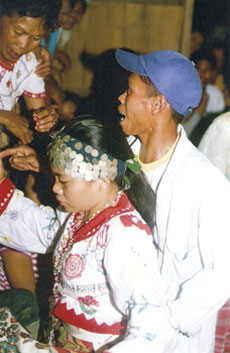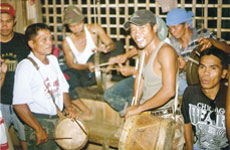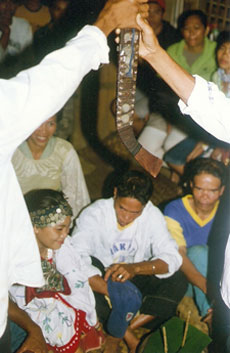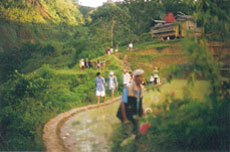Reclaiming an ancient wedding ritual
* No fancy invitations are given out. The call of three kinds of gongs signifies that there is a 'ponsyon' or a feast

She was ten years old when she last witnessed the Lordly Wedding that the Panay-Bukidnon calls "Hungaw". Now at 47, she's anxious to once again see the beauty of the ritual and to hear the lavish poetry of the ceremony.
It was 37 years ago, long forgotten but alive in the blood of every mountain dweller in Panay. Tribal Chieftain Concepdion Diaz wears her "pudong" (head dress) and her "walkos" (belt), both adorned with antique coins, her intricately embroidered "saipang" and headed towards where the "agong" and "tambor" echoes.
"Pahigbok"
No fancy invitations are given out. The call of three kinds of gongs signifies that there is a 'ponsyon' or a feast. One gong is named "kamangyan" because the sound is like a smoke that gives out an inviting smell. The other is "kabungkay" because it makes such a loud sound that awakens people and sparks up their energy for a cultural showdown of dances and chanting. The last gong is "pangindalan" because it leads and guides you to where the feast is. Families in barefoot march down the muddy path towards the home of the bride where the wedding will take place.
"Ponsyon"

One pig, 10 chickens down and one sack of rice to go are one of the things agreed upon before the wedding is set to be provided by the groom's family. "Dinuguan" (pig's blood and innards), "sarciado" (pork and sweet potato and "la-uya" (pig's legs/feet with jackfruit) are served for dinner after a whole afternoon of dancing "Binanog" and exchange of chanting or "Suguidanon".
"Hungaw"
When the pot of rice wine with two "tayok" or bamboo straws are set in the middle, the crowd gathers because the wedding ceremony is about to start. The bride hides in the room with six other maidens while the groom patiently waits to be called. The parents of the bride and the groom are gathered together with two arbitrators, usually respected elders in the community. The bride is represented by the "Tigbabaye" and the groom by the "Tiglalake". A dialogue takes place as they make agreements to what is best for the young couple, Shionny 15 and Joemar 19.
"Anum ka tirik kag isa ka Punay"

Joemar is called to join the elders. Covered in black veil, one by one, the six "tirik" go out of the room and the groom is asked "Is this the girl who stole your heart and you want to marry?" and he will try to identify the girl. If by chance he doesn't recognize his bride, the wedding will be postponed but it is unlikely to happen because the Tigbabaye gives out the clue that the girl who showed up is not his bride. The key word is Punay when the Tigbabaye says "Is this the most beautiful Punay bird who stole your heart and you want to marry?" And the groom will jump in delight, lift the veil of the bride and shouts Yes!
"Pangasi"
The couple listens intently to the advice of the elders. One of the instances that were discussed is about infidelity. If the wife commits adultery, she will return the dowry in double and if the husband commits the same mistake, he will return his wife to her family and pay whatever moral damages the family demands. Also both of their parents agreed that they will help the couple while they are starting their lives. The promise, the vows and the agreement were sealed with the drinking of rice wine in one vessel.
"Bayaw Biit"

The raising of talibung (sword) culminates the wedding and everybody clap their hands. The century-old drumsticks upon the yellowish dried deer skin beat harmoniously with the distinct sound of the gongs. The couple, a little shy and immensely excited for the honeymoon, warms up with a hawk dance or Binanog. While Nang Cone shrieks "Harle, Harlak kati" imitating the sound of a Banog Bird who won the heart of the woman.
Only few couples agree to marry in a traditional wedding, they prefer to marry in the church, the judge or the mayor.
The IPRA law considers traditional wedding ceremonies as legal, as long as the officiating elders are identified by the community and the municipality's local NSO.
